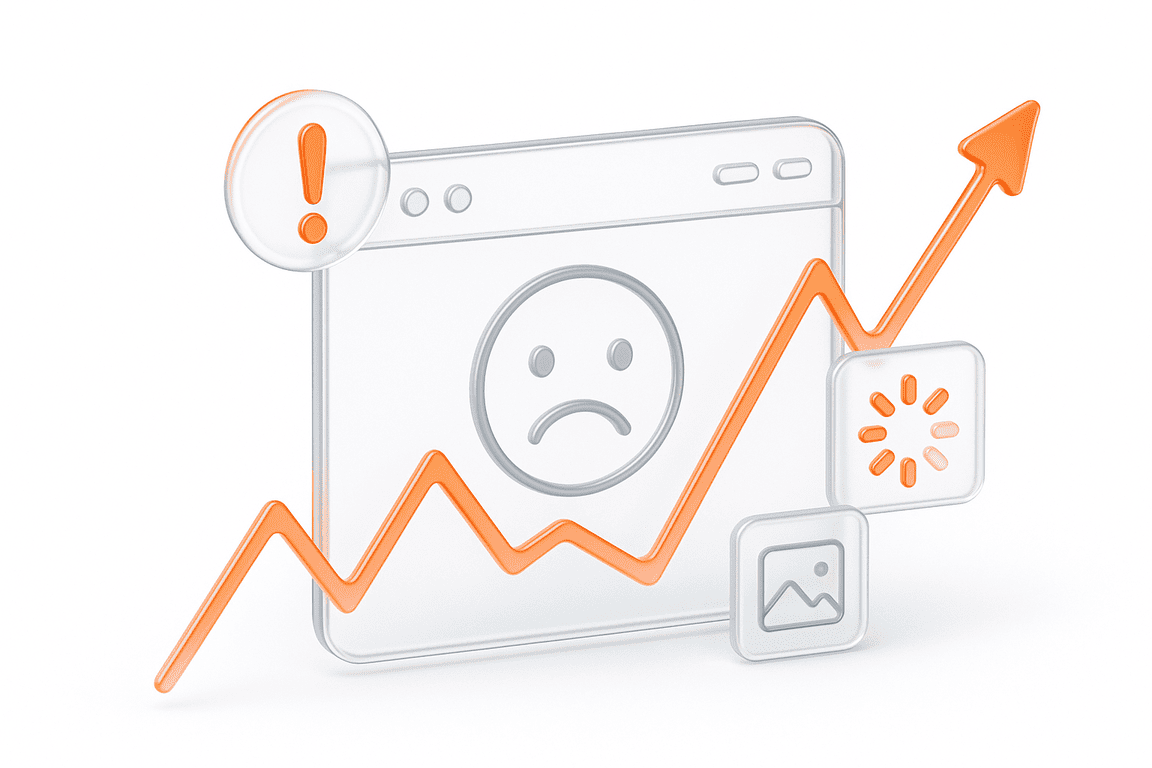You’re pouring money into ads — but is your website ready to handle the traffic?
This article is for digital businesses that rely on conversions to make every click count. Whether you’re running an eCommerce store, a SaaS platform, a marketplace, or a service-based site with an online funnel — your marketing performance hinges on one thing most people overlook: site readiness.
We’ll walk through the hidden technical factors that sabotage your campaign ROI, explain what load testing is, and show you how to ensure your site performs under pressure. Because a campaign that drives traffic is only half the job — the other half is making sure your site can handle it.
Key Takeaways:
What Affects Ad Campaign Efficiency and Conversion Rates
If your site can’t handle the pressure when users arrive, even the best ads will fall flat. Here are the behind-the-scenes factors that directly affect conversion rates during high-traffic campaigns:
1. Page Load Speed
Speed is a direct driver of conversion. A delay of just two to three seconds can lead to significant drop-off, especially on mobile. When your website slows down with high traffic, it sends a clear message to users: this site isn’t ready.
2. Stability Under Peak Load
A successful campaign often causes a surge in visitors. If your infrastructure isn’t built to scale or hasn’t been tested, it can buckle under the pressure. Website crash due to high traffic lead to lost sessions, failed checkouts, and wasted ad budget — all in a matter of seconds.
3. Conversion Path Reliability
Every step in your funnel — from landing page to form submission or purchase — must remain fully operational under load. Traffic surges often expose bugs and failures in the user flow. A website not responsive under load can silently kill conversions even if everything “looks fine” at a glance.
4. Third-Party and Backend Dependencies
Most sites today rely on third-party scripts, payment processors, or CRM systems. If these services aren’t stress-tested alongside your core infrastructure, they become weak points. One slow API call can delay an entire checkout process, especially when user volume spikes.
5. Infrastructure Preparedness for Geo-Distributed Traffic
Modern campaigns often drive traffic from multiple regions — especially if you’re running global ads or influencer campaigns. But if your infrastructure isn’t optimized for geo-distributed traffic, users far from your servers may experience delays, errors, or failed sessions. A website not loading with high traffic isn’t always about volume — sometimes it’s about where that traffic is coming from. To convert consistently, your site needs to perform equally well for every user, regardless of location.
Why Site Stability is Critical to Campaign ROI
Can You Convert Your Traffic?
A website not responsive under load is the fastest way to waste your ad budget. Users click, the page hangs — and just like that, the opportunity is gone. Your acquisition costs stay the same, but the return disappears.
Conversion Killers: Delays, Errors, and Downtime
Just a 1-second delay in page load time can drop conversions by 7%. And when a website crashes due to high traffic or throws up errors mid-funnel, bounce rates spike and trust takes a hit.
Reputation & Retention Impact
Today’s users don’t give second chances. A failed checkout or broken mobile experience doesn’t just lose the sale — it loses the customer. People remember slow sites and error pages, especially if they hit them during a big promo or launch. A poor performance under pressure can turn first-time visitors into long-time skeptics.
What is Load Testing and Why It Matters
You don’t want to find out your site can’t handle traffic when it’s already live — especially not during a campaign. Load testing lets you find weak spots before your users do.
Load Testing Defined in Simple Terms
Load testing is the process of simulating real-world traffic conditions to see your website performance under heavy traffic. The goal is to identify how many users your system can handle before it slows down, breaks, or fails.
What Load Testing Helps Identify
Load testing reveals the cracks before real users find them. It uncovers slow database queries, overloaded servers, unstable third-party services, memory leaks, and other performance bottlenecks. It helps you optimize site for traffic spikes before launch day — not during it.
How It Differs from Other Types of Performance Testing
Load testing checks if the websit still works when everyone shows up at once. While stress testing pushes systems to their absolute limit, load testing focuses on expected real-world user volumes and how the site performs under typical campaign-level load.
How Load Testing Helps Prepare for High-Traffic Campaigns
High-traffic events aren’t limited to Black Friday. They include ad blitzes, seasonal promos, influencer shoutouts, viral social posts, product drops, and newsletter blasts. Anything that drives a sudden spike in traffic qualifies — and each one has the potential to break a site that isn’t prepared.
Why They’re Risky Without Preparation
There’s often a gap between the scale of your campaign and the readiness of your infrastructure. This mismatch leads to traffic bottlenecks, failed sessions, and lost sales. A website not working with many users during a key campaign can undo months of planning.
Simulate the Real Load Before You Go Live
With load testing, you can simulate campaign-level traffic before launch. It’s like a rehearsal: you see how your site handles real pressure, without risking your actual traffic. This is how you fix website issues for high traffic before they cost you conversions.
Predict Bottlenecks and Fix Them Early
Load tests don’t just show if your site will break — they show where and why. A checkout queue, slow CMS response, or a third-party API that’s choking — catching it early means you don’t have to troubleshoot mid-campaign.
Optimize Infrastructure Costs
Not every fix means scaling up. Load testing helps you right-size your hosting and infrastructure, so you’re not overpaying just to “play it safe.” You increase website capacity where it matters — not across the board.
What Happens If You Don’t Load Test?
Skipping load testing before a major campaign is like launching without checking your landing gear. You might get away with it once — but eventually, it’s going to crash.
Wasted Ad Budget
You paid for the traffic. If your site can’t handle it, you’re not just losing conversions — you’re actively throwing money away. Every bounce caused by slow loading or a broken flow is a wasted click, a wasted dollar, and a missed chance to grow.
Lost Sales Opportunities
Campaign windows are short. Users won’t wait around if your site stalls. A website not loading with high traffic doesn’t just delay sales — it kills them entirely.
Reputation Damage
In digital, trust is fragile. A single failed experience during a promo or launch can damage your brand more than you think. Users share screenshots. They post reviews. They don’t forget. And once you’re labeled as unreliable, you’ve got to spend twice as much to win them back.
How We Prepare Websites for High-Traffic Events
At PFLB, we don’t guess. We test. Here’s how we help digital businesses get their websites campaign-ready — without the risk.
1. Define Expected Load Based on Campaign Scope
We start by understanding your campaign goals — estimated traffic volume, geographic distribution, peak times, and user behavior. We model traffic scenarios based on your actual marketing plan.
2. Build Realistic Load Testing Scenarios
Using your site’s actual user flows — sign-ups, product searches, checkouts, etc. — we simulate concurrent users and behavior under pressure. This reveals how your system performs under realistic high-load conditions, not just synthetic benchmarks.
3. Identify Bottlenecks Across the Stack
We analyze how every layer of your system responds — front-end, back-end, third-party services, databases. If your website slows down with high traffic or stalls entirely, we pinpoint where and why it happens.
4. Deliver Fix Recommendations You Can Act On
We provide recommendations on how to optimize site performance under heavy traffic, scale infrastructure where needed, and eliminate risky weak points before the campaign goes live.
Final Thoughts: Don’t Let Your Site Be the Weakest Link
You can have the best targeting, the biggest ads, and a perfectly timed campaign, but if your site lags, crashes, or stalls under pressure, none of it matters. Performance issues break the flow, kill the momentum, and quietly drain your ROI.
Load testing closes the gap between marketing and technical readiness. It ensures your site performs when it matters most — during high-traffic, high-stakes moments. Because at the end of the day, performance is conversion.
Related insights in blog articles
Professional vs. In-House Website Load Testing: Which One Do You Really Need?

Thriving in the fierce digital space is what every business strives for. While high-traffic events like targeted marketing campaigns, paid ads, product launches, and seasonal spikes certainly help win over customers and skyrocket sales, they also abruptly expose hidden website vulnerabilities to users. To assess website readiness for traffic surges and prevent weaknesses, such as […]
How Website Performance Impacts E-Commerce Sales and Cart Abandonment

Every e-commerce store has mere milliseconds to make the right impression on shoppers. When prospects land on a product page, they assess every single metric, and e-commerce website performance and speed are the most critical ones. In most scenarios, impatient users will bounce instantly — at the slightest hint of latency caused by high loads […]
10 Signs Your Website Can’t Handle Traffic Spikes: Everything you need to know

Your campaign goes live, clicks start pouring in, and traffic shoots up fast. It’s the moment you’ve been waiting for, until everything slows down. Pages take ages to load, checkout freezes, and visitors disappear before they can buy. It’s a frustrating twist: the success of your marketing draws in more people than your website can […]
Why Averages Lie: Mathematical Methods for Load Testing

Relying on “average” metrics alone makes load testing surprisingly inaccurate. In this article, we’ll show how to avoid the usual traps and walk through practical techniques for mathematically modelling a workload profile, from analyzing variance and correlations to spotting Simpson’s paradox and validating the final model. When a company moves to a new system, the […]
Be the first one to know
We’ll send you a monthly e-mail with all the useful insights that we will have found and analyzed
People love to read
Explore the most popular articles we’ve written so far
- Top 10 Load Testing Tools for 2025: The Deep Dive Sep 9, 2025
- Cloud-based Testing: Key Benefits, Features & Types Dec 5, 2024
- Benefits of Performance Testing for Businesses Sep 4, 2024
- Android vs iOS App Performance Testing: What’s the Difference? Dec 9, 2022
- How to Save Money on Performance Testing? Dec 5, 2022






